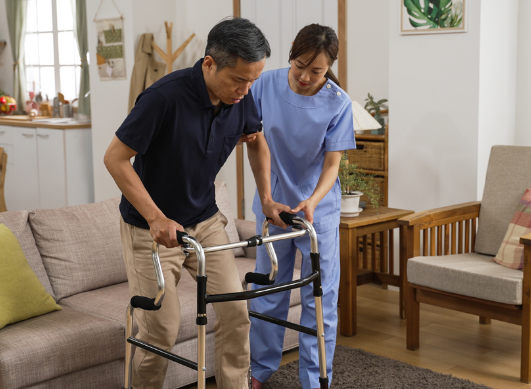Post-stroke complications: how can they be avoided?
Published Oct 29, 2023 • By Candice Salomé
Also known as a stroke, cerebrovascular accident (CVA) is a rupture or obstruction of a blood vessel situated in the brain. Because of the irreversible effects it can have on the brain, it is an absolute medical emergency that requires you to call the emergency number (911) for immediate treatment.
So what are the signs of a stroke? What irreversible consequences can a stroke have? How are post-stroke complications treated?
We explain it all in our article!

What is a stroke (cerebrovascular accident)?
There are more than 795,000 new cases of stroke per year in the United States. Stroke is the fifth leading cause of death and disability among the adult population.
The average age at which a stroke occurs is 74, but 25% of people affected are under 65 and 10% are under 45.
There are two types of stroke:
- Transient ischemic attack (TIA), which is a mild form of stroke, caused by the temporary interruption of blood flow to parts of the brain. In a TIA, symptoms last less than an hour and leave no abnormal signs on MRI images of the brain.
- A cerebrovascular accident (CVA) is characterized by damage to part of the brain as a result of the blockage or rupture of a blood vessel. It must be treated quickly to avoid irreversible damage and facilitate recovery.
Stroke symptoms appear suddenly. They include:
Source: American Stroke Association
What are the consequences of a stroke?
Stroke causes brain damage that can be irreversible. When neurons are deprived of oxygen as a result of vascular obstruction, around 2 million of them die every minute. This is why stroke must be treated as quickly as possible - in order to minimize the time between the first signs and treatment, and to unblock the blocked artery. With current treatments, the time it usually takes to intervene is just a few hours.
The severity of a stroke varies. It can range from a TIA that regresses in a few minutes without leaving any after-effects, to a severe stroke leading to death, or a stroke that leaves more or less serious but permanent sequalae.
Hemiplegia
When stroke affects the motor area of a cerebral hemisphere (right or left side), the opposite part of the body may be paralyzed. The paralysis of the right or left side of the body is called hemiplegia.
A stroke that affected the left side of the brain can cause right-side hemiplegia.
Speech disorders
In the event of a stroke, the area responsible for language control may also be affected, leading to language disorders known as "aphasia". This can take the form of difficulty in articulating or finding words.
Hemineglect of the surrounding area
After a stroke, some people may ignore one side (the right or the left, depending on which side is affected) of the area around them. For example, when crossing the road, they may completely ignore what comes from the left, while registering perfectly what comes from the right.
Pain
After a stroke, physical pain may appear on the affected side. This pain may be due to permanent muscle tension.
Some shoulder pain may be linked to a sequela called "algodystrophy" (excessive pain in a body joint, associated with inflammation and joint stiffness).
Other sequelae may arise after a stroke, such as, for example:
- Sphincter disorders, resulting in the inability to urinate or, on the contrary, a constant urge to urinate,
- Sexual problems such as loss of libido, erectile dysfunction or ejaculation disorders,
- Fatigue and difficulty concentrating,
- Depression, anxiety and irritability.
How can the consequences of a stroke be treated?
Stroke rehabilitation should begin as soon as possible, because the sooner it begins, the better the patient's chances of regaining lost abilities and skills. The length of rehabilitation varies according to the complications.
There are various approaches to stroke rehabilitation, and the rehabilitation plan will depend on the part of the body or the ability affected by the stroke.
Exercising
The aim of motor skills exercises is to strengthen muscles and improve coordination. This may, for example, include exercises to strengthen swallowing.
Improving mobility also involves learning to use mobility aids, such as a cane, wheelchair, splint, etc.
Range-of-motion therapy relieves muscular tension and helps regain an optimal range of movement through certain exercises and treatments.
Technologically assisted physical activity
One example is functional electrical stimulation: electricity is applied to weakened muscles, forcing them to contract.
Robotic devices can also be of help: with their assistance weakened limbs perform repetitive movements to regain strength and function.
Cognitive and emotional activities
Occupational therapy and speech therapy help improve cognitive abilities such as memory, problem-solving and social skills, etc.
Support groups allow patients to feel listened to and supported.
Finally, drug treatment, such as antidepressants or medication for alertness, agitation and movement may be recommended.
Take care!
Sources :
Troubles du comportement et du caractère après un AVC, Centre Hospitalier Universitaire de Nantes
Séquelles d’un AVC, Ramsay Santé
Accident vasculaire cérébral (AVC), Inserm
AVC ischémique : les complications, Medisite
Accident vasculaire cérébral (AVC), Vidal
Comprendre l'accident vasculaire cérébral et l'accident ischémique transitoire, Ameli

 Facebook
Facebook Twitter
Twitter


